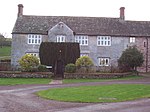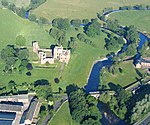Clifton and Lowther railway station
1846 establishments in EnglandClifton, CumbriaDisused railway stations in CumbriaFormer Lancaster and Carlisle Railway stationsPages with no open date in Infobox station ... and 3 more
Railway stations in Great Britain closed in 1938Railway stations in Great Britain opened in 1846Use British English from January 2018

Clifton & Lowther railway station was a station on the Lancaster and Carlisle Railway (L&CR) south of Penrith near to the village of Clifton. Although it was the original terminus to cross Pennines rail traffic on the Eden Valley Railway, it was rapidly by-passed by a new line and junction. The station, which was on the West Coast Main Line, was treated as a private stop by the Earls of Lonsdale.
Excerpt from the Wikipedia article Clifton and Lowther railway station (License: CC BY-SA 3.0, Authors, Images).Clifton and Lowther railway station
Clifton Moor Cottages,
Geographical coordinates (GPS) Address Nearby Places Show on map
Geographical coordinates (GPS)
| Latitude | Longitude |
|---|---|
| N 54.618276 ° | E -2.713119 ° |
Address
Clifton & Lowther Junction
Clifton Moor Cottages
CA10 2EZ , Clifton
England, United Kingdom
Open on Google Maps









